When I read last Friday evening that most, if not all, of the global strategic maple syrup reserve had been stolen, my first response was not to fear for North America’s waffles or pancakes, but rather to wonder at the very existence of such a reserve. After all, the terms “global,” “strategic,” and “reserve,” are more often used with respect to petroleum, currency, or the smallpox vaccine than waffle-toppers.
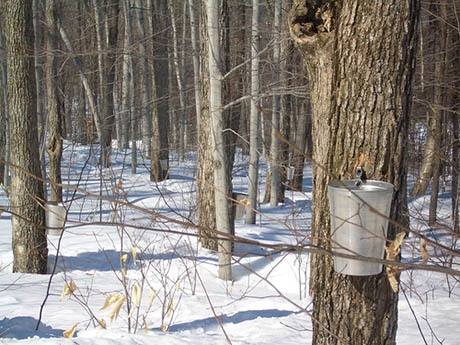
IMAGE: Maple tapping in Quebec, via.
And, indeed, the Quebecois warehouses that formerly housed 10 million pounds, or 30 million Canadian dollars’ worth, of maple syrup, is not some kind of U.N. stockpile held in the common good against future trans-national breakfast catastrophes. In fact, as The Atlantic helpfully explained, it is a global and strategic reserve purely by virtue of the fact that “Quebec taps 75 percent of the world’s supply, and its producers have been attempting to grow their market abroad.”

IMAGE: The International Strategic Syrup Reserve, photographed in 2011 by Francis Vachon for The Globe and Mail.
Because of the risk that short supply and price hikes would pose to that market expansion, the Federation of Quebec Maple Syrup Producers skims off the surplus in good years, to stockpile against a weak harvest. After all, as maple expert Michael Farrell explained to The Atlantic’s Jordan Weissman, “If you are trying to develop a market for something, you don’t want to create a demand and not be able to supply it.”
In other words, Canada’s (former) syrup stockpile is maintained for the benefit of maple tappers, rather than as a global breakfast insurance policy. In that respect, it is more like the EU’s legendary, and recurring, wine lakes and butter mountains — the result of surplus production, deliberately held back to prevent market volatility.

IMAGE: A symbolic EEC surplus butter mountain photographed at a British Labour Party Gala Morning in 1984, via.
(To my mind at least, it’s also similarly evocative, by which I mean that it’s hard not to imagine skiing down the butter mountain, floating lazily in syrup tank, or merrily boating across the wine lake. Sadly, in reality, the wine lake is usually re-purposed as industrial alcohol through “crisis distillation,” the butter mountain, which is apparently “more of a butter molehill” these days, consists of bulk blocks held in cold storage warehouses across the continent, and the stolen syrup reserve was stored in steel oil drums stacked five high.)

IMAGE: Alex James floating on culinary magicians’ Bompas & Parr’s lake of punch, via.
But while the EU’s amusingly-named surplus storage is the outgrowth of a protectionist quota system, and Quebec’s rather endearing maple syrup stocks form part of an industry-sponsored strategic growth strategy, globally, a growing number of policy experts are calling for the establishment of food reserves as a vital safety net for the hungry consumer.
As Foodprint Toronto panelist Evan Fraser explained in his 2010 book, Empires of Food: Feast, Famine, and the Rise and Fall of Civilizations, co-authored with Andrew Rimas, food reserves are actually one of the oldest food security strategies in the book. He is fond of reminding policymakers of the Old Testament story of Joseph, the Pharoah, and the seven skinny cows eating the seven fat cows, as a demonstration of the value of saving food in years of plenty, in order to sustain the populace during the inevitable lean ones.
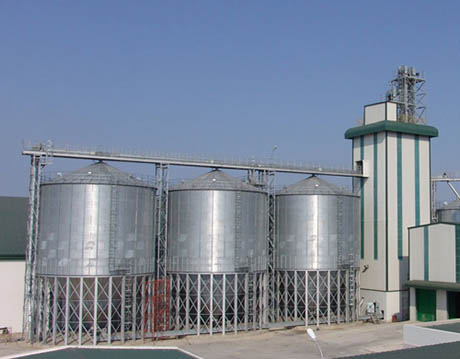
IMAGE: Steel silos in China, used for oil and grain storage, via.
These kinds of reserves — a national stockpile held to ensure food security in the event of an emergency — used to be commonplace, but have largely disappeared in the last twenty years. The U.S. eliminated its last grain reserves in the 1996 “Freedom to Farm” Act, while a U.N.-led effort to establish a network of grain reserves in developing nations following food price spikes in the 1970s fizzled out a decade later in an embarrassing combination of corruption, price fixing, and pest damage, as well as the new orthodoxy of free market efficiency.
Since then, the reigning assumption has been that global trade can distribute harvests more efficiently than human design. This may be, but we still live in a world where one billion people are hungry and an equal number are overweight or obese, while more than a billion tons of food are wasted each year.
What’s more, reserves are expensive to maintain, and countries that could afford them can usually import their way out of shortages instead. Poor countries, on the other hand, can’t afford either, leaving them extremely vulnerable when harvests fail and food prices rise.
For example, a 2011 Food and Agriculture Organization report on the world food crisis of 2007 and 2008, in which a shortfall was caused by a combination of droughts and high oil prices (and exacerbated by a host of other hotly disputed factors, including the rise of biofuels), noted that the resulting price spikes caused an 8 percent increase in the number of malnourished people in Africa.
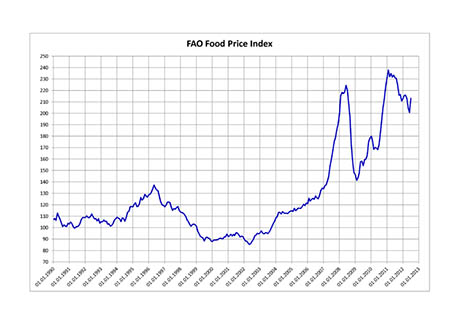
IMAGE: Food price index charted from 1990 to the present, via.
In an era of climate change, which means disruptive weather and increasingly variable harvests, food prices are predicted to remain volatile and high. In addition to all the aspects of a balanced food security strategy (reducing waste, increasing harvests, improving water storage and transportation infrastructure, and so on), a growing chorus of think tank papers and op-eds are arguing in favour of re-establishing some kind of food reserve system.
This presents a fascinating design challenge, in terms of physical infrastructure and architecture, as well as operations, economics, and geopolitics.
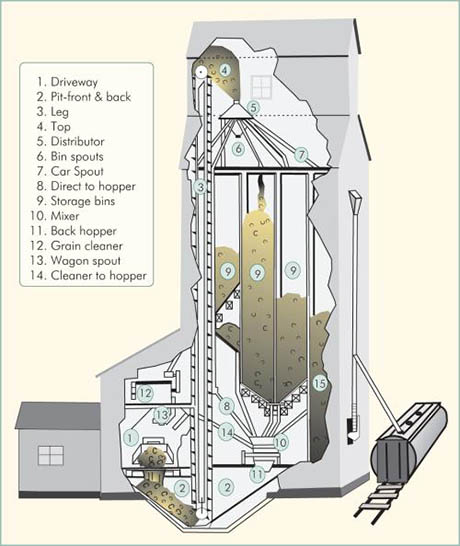
IMAGE: Grain elevator cutaway, via the Canadian Plains Research Center.
Current reserve plans and proposals come in all shapes and sizes. For example, in 2010, Joachim von Braun and Maximo Torero of the International Food Policy Research Institute outlined an anti-food price speculation device they called a “virtual reserve.”
In their proposal, the U.N., World Bank, or similar international institution would be responsible for managing a “fund,” consisting of dollar commitments from grain-producing countries that together add up to between 30 to 50 percent of normal grain trade volume. If grain prices started to rise above a certain agreed-upon point, the fund could call in those commitments in order to execute a series of short sales on the futures market, which would, in theory, bring spot prices down and drive speculators out.
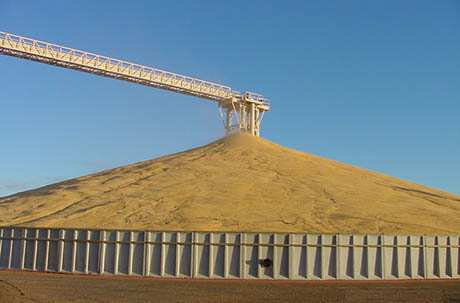
IMAGE: Grain bunker built over grain reclaim tunnels, via Hanson Silo.
Meanwhile, in a 2011 report, grain industry consultant David McKee inventoried physical reserve infrastructure and building initiatives from around the world, from Jordan’s new 100,000-tonne-capacity concrete grain elevator to Qatari plans for “a huge underground grain storage bunker that would protect a wheat reserve from radioactive fallout in case of a nuclear catastrophe in nearby Iran,” and from China’s shiny steel silos full of wheat (thought to hold 60 million tonnes, although the exact total is a state secret) to India’s “jute bags piled on raised earthen platforms called plinths and covered with tarpaulins.”
Siting a national food reserve is also not straightforward, depending on internal transportation infrastructure and how the country is connected to either local or global markets. Regional reserves, such as East Asia’s Emergency Rice Reserve, are almost inevitably distributed in their member country’s national storage facilities for political reasons as well as efficiency.
But perhaps the most challenging aspect of food reserve design is managing it: preventing loss from pests, heat, theft, or mould, rotating stock to keep it fresh, maintaining volume, and planning for distribution.
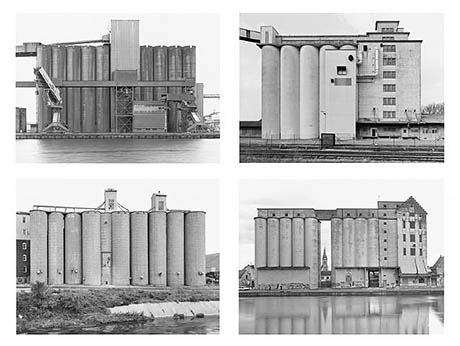
IMAGE: Grain elevators, Bernd and Hiller Becher, via.
The infrastructure of bulk food storage has hardly evolved from the concrete cylinders so admired by Le Corbusier at the start of the twentieth-century; the time thus seems right to imagine a new networked architecture, both functional and monumental, circulating, cooling, and protecting its contents through a series of suction aeration fans, gravity-fed conveyor belts, temperature and moisture sensors, pneumatic dust suppression systems, floor perforations, partitions, chutes, pressurised seals, and more.
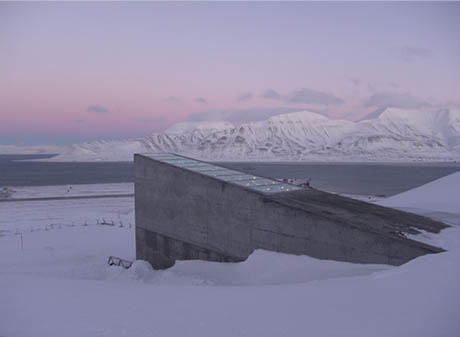
IMAGE: Svalbard Global Seed Vault, photographed by Mari Tefre, via.
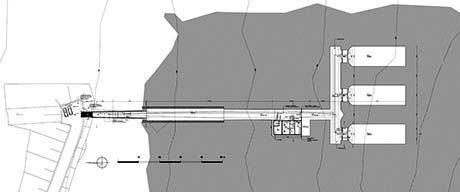
IMAGE: Svalbard Global Seed Vault, drawing by The Directorate of Public Construction and Property, via.
Local dietary production and preferences, as well as theft and corruption controls, could be built into storage unit design, which would stretch far beyond the form of physical units to include paved roads and trade agreements, not to mention meteorological and market intelligence units. The design of Svalbard’s International Seed Vault captured architectural imaginations around the world: perhaps it’s time to apply that creativity to imagining the future of food reserves…

